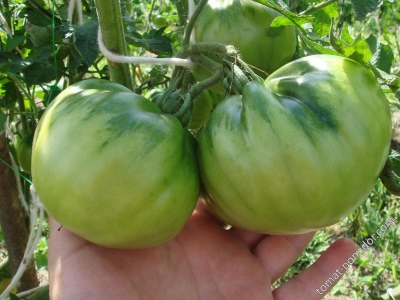
- Authors: Gavrish S.F., Morev V.V., Amcheslavskaya E.V., Degovtsova T.V., Volok O.A.
- Year of approval: 2002
- Category: hybrid
- Growth type: indeterminate
- Appointment: fresh consumption
- Ripening period: late ripening
- Ripening time, days: 125-127
- Growing conditions: for film greenhouses
- Marketability: high
- Bush size: tall
Tomato hybrid Russian size is the choice of summer residents who prefer large-fruited plants in their greenhouses. Tall bushes are unpretentious, protected from most diseases, show amicable and stable fruiting.
Description of the variety
Indeterminate hybrid forms tall bushes with medium branching shoots. The foliage is strong, the tops thinning may be required. The formation takes place according to the potato type. The color of the tops is dark green, the sizes of individual plates are large. The first inflorescence is laid high, above the 9th leaf, the next in 3-4.
The main qualities of the fruit
The tomatoes in this hybrid are large, weighing up to 630 g. The shape is traditional, flat-round, with slight ribbing. The skin is smooth, first colored in a light green shade, then red.
Taste characteristics
The fruit has a pleasant sweet taste. They are intended for fresh consumption, good in salads and as juices.
Ripening and fruiting
The hybrid is late maturing. Harvesting begins 125-127 days after planting. Fruiting is extended, starts in August and lasts until frost.
Yield
High-yielding variety. If you follow all the recommendations for growing, you can harvest fruits at 7-8 kg / sq. m. From 1 plant, the collection is 4-5 kg.
The timing of planting seedlings and planting in the ground
It is customary to start sowing seeds for seedlings early. The optimal dates are from late February to early March. Plants are transferred to prepared greenhouses starting from the end of April, at the age of 50-55 days, counting it from the moment of emergence.

Growing tomato seedlings is an extremely important process, because it largely depends on whether the gardener will be able to harvest at all. All aspects must be taken into account, from seedbed preparation to planting in the ground.
Landing scheme
The standard distance between the bushes when planting should be 40 × 60 cm. It is not recommended to thicken the tomato plantation. There should be no more than 2-3 bushes per 1 m2.

Growing and care
The hybrid Russian size needs to complete the entire range of agrotechnical measures. A tall tomato is formed into 1 stalk, be sure to stepchild and tie up. Fastening to the support is carried out a few days after planting in the ground. Growing is recommended in greenhouses - under a film or in a glazed shelter.
Grasshopping is carried out completely, the lower leaves are also removed up to 1 inflorescence. The growing point is pinched at the end of the growing season. Frequent fertilization is not required, moreover, overfeeding with nitrogen is dangerous for plants and can negatively affect fruiting. Instead of organic, it is better to use potash and phosphorus additives, including fishmeal. In addition to the benefits for the bushes themselves, they also have a beneficial effect on the taste of tomatoes.
Watering the bushes also requires some attention. It must be regular and abundant for the plant's root system to develop normally. If these recommendations are violated, fruits will form on the sides of the bush, but not over its entire area. In addition, in the event of unfavorable factors - extreme heat or cold snap - tomatoes will stop gaining useful substances. About 1 liter of water is consumed for 1 bush at a time.
Loosening is another step in leaving. In greenhouses, the soil is worked out both in rows and between them. You need to repeat the manipulations every 10 days. Heavy, dense soils are loosened every 2 weeks. Hilling begins 10 days after transplanting the bushes into greenhouses, then after 21 days it is repeated.
Large-fruited tomatoes need rationing. As soon as 1 tomato about 5 cm in diameter appears on the lower part of the brush, 2-3 more fruits are left on it. The rest are cut off, as are the extra inflorescences. This will allow you to get a rich harvest without overloading the bush. Collection of fruits for long-term storage is carried out when the skin is browned.




A plant needs different micronutrients at each stage of growth. All fertilizers can be divided into two groups: mineral and organic. Folk remedies are often used: iodine, yeast, bird droppings, eggshells.
It is important to observe the rate and period of feeding. This also applies to folk remedies and organic fertilizers.
Disease and pest resistance
The hybrid is genetically highly resistant to TMV, cladosporiosis and fusarium wilt. It is better to carry out prevention against late blight. You can choose a chemical fungicide or biologics. Among the pests for tomato, the most dangerous are the bear, whitefly, nematode and wireworm. When they are identified, methods of struggle are selected individually.


Resistant to adverse weather conditions
The variety is not intended for outdoor use. It is poorly adapted to growing in adverse weather conditions. Tomatoes need plenty of sun and warmth to fully ripen.
Review overview
According to summer residents, the Russian size tomato has shown itself quite well both in private and commercial cultivation.Amateur vegetable growers are satisfied with record yields, they recommend planting 2 bushes per 1 m2, but they warn that they grow up to 2 m tall. When building a greenhouse, this will have to be taken into account. When administered in 2 trunks, the tomatoes are smaller, but fruiting remains abundant.

























































































